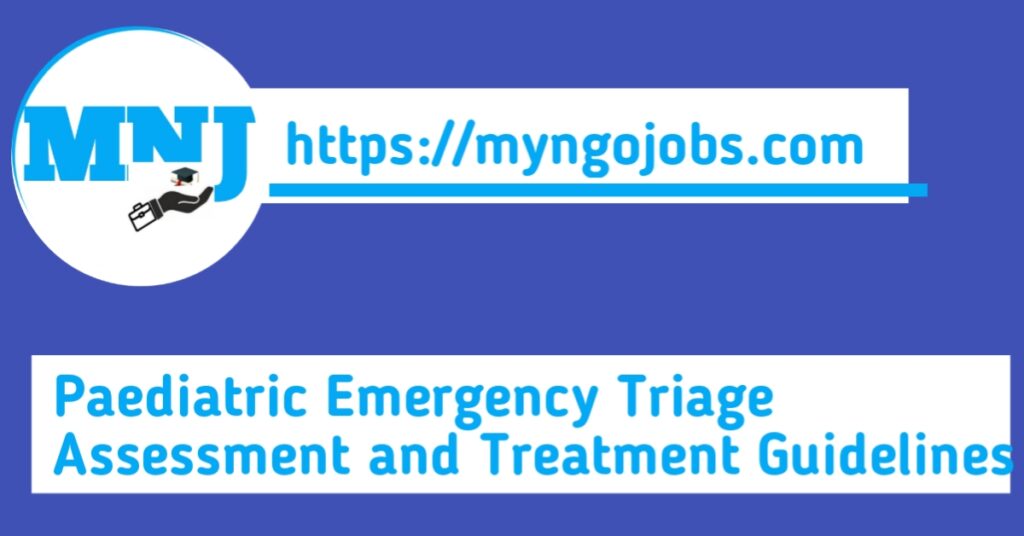In a health care setting, saving life starts from who needs immediate medical attention not who come first. The method we use to sort out these kind of patient is called Triage, in this article we will look into the complete details of what triage is and how to perform triage.
Learning Outcome
By the end of this post, you will be able to:
- Understand what Paediatric Emergency Triage Assessment and Treatment (ETAT) means.
- Know the steps involved in paediatric triage guidelines.
- Learn how to quickly identify emergency conditions in children.
- Understand the meaning of triage colors like red, yellow, and green.
- Understand key concepts like ATS, the 3 P’s of First Aid, 4 principles of triage, 4 B’s, and 5 S’s of triage.
- Be more confident in managing emergency situations involving children.
Topic Contents Outline
- What is Paediatric Emergency Triage Assessment and Treatment (ETAT)?
- Importance of ETAT in saving children’s lives
- What are the emergency conditions for paediatric patients?
- What are the colours in triage and what does the red mean?
- What is ATS in triage?
- Understanding the 3 P’s of First Aid
- What are the 4 principles of triage?
- Knowing the 4 B’s of triage
- Exploring the 5 S’s of triage
- Key steps in paediatric triage guidelines
- Common signs of emergency, priority, and non-urgent cases
- Practical tips for treating children during triage
- The role of nurses, doctors, and caregivers
- Conclusion, Self-Assessment, and References
Read also: How to apply for UNICEF volunteer in Nigeria
Topic Goal
The goal of this topic is to provide clear, easy-to-understand guidance on Paediatric Emergency Triage Assessment and Treatment. It will help healthcare workers, caregivers, and students to recognize emergency signs, follow proper triage steps, and treat children quickly to save lives. This guide also helps with basic knowledge for those working in hospitals, clinics, or humanitarian settings.
Introduction
Children are among the most vulnerable in emergencies. Whether it’s a fever, difficulty in breathing, or an accident, children need quick and proper care to survive. This is where Paediatric Emergency Triage Assessment and Treatment (ETAT) comes in. It helps health workers know which child needs help first and what treatment to start immediately.
Every second matters when a child is sick or injured. This is why knowing the paediatric emergency triage guidelines can make a huge difference. In this guide, we will explain in simple words how to assess and treat children during emergencies using the ETAT system. We will also answer key questions like “What does red mean in triage?”, “What is ATS?”, and “What are the 3 P’s of First Aid?”.
Read also: How to Deal with Job Search Anxiety and Stay Motivated
Topic Content
What is Paediatric Emergency Triage Assessment and Treatment (ETAT)?
ETAT stands for Emergency Triage Assessment and Treatment. It is a method used in hospitals and clinics to quickly check sick children and decide who needs treatment first.
In busy places with many children, like emergency rooms or clinics during disease outbreaks, ETAT helps save lives. It gives simple steps to follow when a child arrives and shows signs of being seriously ill.
Why ETAT is Important
Every year, many children die because they don’t get help on time. ETAT was created to stop this. It helps nurses and doctors:
- Identify very sick children in less than 1 minute.
- Decide who needs immediate care.
- Start life-saving treatments quickly.
- Prevent unnecessary deaths in children under five.
What Are the Emergency Conditions for Paediatric Patients?
Emergency conditions in children include:
- Difficulty in breathing
- Severe bleeding
- Convulsions or fits
- Shock (cold hands, weak pulse)
- Severe dehydration
- Very low or high body temperature
- Loss of consciousness
- Not able to breastfeed or drink
These are emergency signs that show a child must be seen and treated immediately.
Read also: USAID Aid Cuts: A Crisis for Millions in Need in Nigeria
What Do the Colours Mean in Triage? (Red, Yellow, Green)
Triage uses colors to group patients based on how sick they are:
Red: Emergency. The child needs help immediately.
Yellow: Priority. The child is sick but can wait a short time.
Green: Non-urgent. The child has mild illness and can wait longer.
So, what does red mean in triage? It means the child is very sick and could die without fast treatment. Always treat red cases first.
What is ATS in Triage?
ATS stands for Australasian Triage Scale. It is used mostly in Australia and some other countries. It helps health workers sort patients by how urgent their condition is. It has five levels:
Level 1: Immediate (life-threatening)
Level 2: Emergency (within 10 minutes)
Level 3: Urgent (within 30 minutes)
Level 4: Semi-urgent (within 60 minutes)
Level 5: Non-urgent (within 120 minutes)
Though ATS is not the same as ETAT, both are useful tools for organizing care in emergencies.
What Are the 3 P’s of First Aid?
The 3 P’s of First Aid are:
Preserve life – Keep the child alive.
Prevent worsening – Stop the condition from getting worse.
Promote recovery – Help the child get better.
These 3 steps guide how we help any patient, including children, during emergencies.
Read also: 5 Ways to Manage Stress in the Workplace
What Are the 4 Principles of Triage?
The 4 principles of triage help in sorting and managing patients:
- Do the most good for the most people.
- Save resources for those who can be saved.
- Treat in order of urgency, not arrival time.
- Re-assess regularly as conditions can change.
These principles ensure fair and effective care, especially when many children need help at the same time.
What Are the 4 B’s of Triage?
The 4 B’s of triage refer to important areas to check during triage:
- Breathing
- Bleeding
- Burns
- Bones
These B’s help health workers quickly identify life-threatening problems.
What Are the 5 S’s of Triage?
The 5 S’s are helpful memory tools for quick response:
Safety – Ensure the child and caregiver are safe.
Scene – Understand what happened.
Shout for help – Call for more staff if needed.
Start assessment – Begin checking the child.
Send to right area – Emergency, priority, or non-urgent.
Understanding the Paediatric Triage Guidelines
When a child comes to a health facility, triage follows three steps:
Emergency signs – If present, give treatment immediately.
Priority signs – If present, the child waits shortly for treatment.
No danger signs – Child is non-urgent and can wait.
Examples of emergency signs:
- Not breathing or severe breathing
- Fits
- Shock
- Coma
- Severe trauma
Examples of priority signs:
- High fever
- Severe pain
- Vomiting everything
- Severe pallor
- Burning with urination
- Ear discharge in a baby
If no emergency or priority signs are found, the child is marked as green and can wait.
How to Assess a Child in Emergency Triage
Quick assessment follows the ABC approach:
A – Airway: Is the child’s airway clear? Any blockage?
B – Breathing: Is the child breathing fast or with difficulty?
C – Circulation: Is the pulse strong or weak? Are hands cold?
Also check:
- Level of consciousness
- Ability to drink or breastfeed
- Look for signs of injury, bleeding, or swelling
Basic Treatment for Emergency Conditions
Once an emergency sign is found, treatment should start immediately, even before referral.
Some common treatments:
- Give oxygen if breathing is difficult.
- Give fluids if the child is in shock.
- Give anticonvulsants if the child is having a seizure.
- Keep the child warm if temperature is low.
- Start antibiotics if infection is suspected.
Nurses, Doctors, and Caregivers: Working Together
- Nurses often perform triage and give first aid.
- Doctors make decisions about diagnosis and treatment.
- Caregivers (like parents) provide history and help comfort the child.
Good communication and teamwork are important. Triage is not just about the health workers, but also about making caregivers part of the process.
Practical Example of Triage
Let’s say a 2-year-old boy is brought to the clinic. He is not breathing well, has cold hands, and is not responding.
- First, the nurse checks ABCs.
- He is not responsive = Emergency sign.
- He is marked RED.
- Oxygen is given and the doctor is called.
- The nurse continues with supportive care.
This is how triage saves lives when done correctly.
Conclusion
Paediatric Emergency Triage Assessment and Treatment is a life-saving approach in hospitals and clinics. By identifying emergency signs early and starting quick treatment, many children’s lives can be saved. This guide showed you the meaning of triage colors, how to assess a sick child, and the steps in treatment.
We also discussed important terms like ATS, the 3 P’s of first aid, 4 principles of triage, 4 B’s, and 5 S’s. Whether you are a nurse, student, or caregiver, understanding ETAT can help you respond faster and better during a child’s emergency.
Always remember: Quick action saves lives.
Self-Assessment
- What does the color red mean in triage?
- Name three emergency signs in a child.
- What does ETAT stand for?
- What are the 3 P’s of First Aid?
- What are the four principles of triage?
- What does ATS stand for in triage?
- Why is it important to do triage quickly?
References
- World Health Organization. (2005). Emergency Triage Assessment and Treatment (ETAT) Guidelines.
- UNICEF. (2023). Child Health and Emergency Care.
- Australasian College for Emergency Medicine. ATS Triage Handbook.
- WHO Pocket Book of Hospital Care for Children. 2nd Edition.
- Global Health Media Project – Emergency Care for Children.

